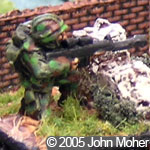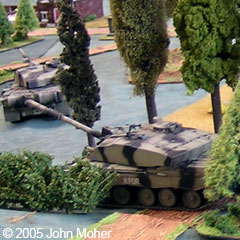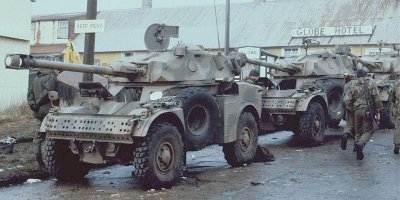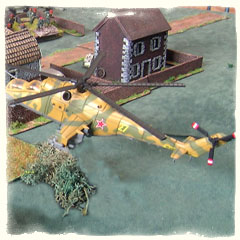
The Modern period traditionally covers everything from the Korean War in 1950 through to the present day. The sheer number of conflicts is actually pretty staggering and as someone once said there is a war in progress somewhere round the globe every single day (a pretty sad fact really). In the past I have mainly been interested in the Arab-Israeli conflicts and the potential European confrontations generated by the Cold War – these interested resulted in my being a co-author of the Modern Spearhead (© 2000) rule set for modern Brigade to Corps level battles with micro-armour. However in recent years as I have moved away from gaming in smaller scales such as 1/285th micro-armour, and to some extent that Grand-Tactical type of game, I have revisited my interest in other modern conflicts. As a result I’m now slowly starting to game these at the Company & Battalion level in 1/76th (20mm) using Crossfire.
Crossfire can easily be adapted to the modern era, and does not require an ‘arms race’ to do so. Most people who have adapted Crossfire mechanics to the modern era have, I’ve noticed, focussed on the perceived increased fire power, and often also reduced the troop scale to 1:1 (i.e. a stand is a Fire Team of 3-4 men rather than a Squad of 6-12, and each real-life Squad has 2 stands on table – a rifle team and a LMG team). However in my view this results in excessive increases to the fire power “in the game” ending up with troops regularly firing with 4D or even 5D! These should be exceptions, not the norm! It also loses sight of the level of abstraction in Crossfire and non-linear treatment of how (real world) actions/events are presented in the game.

My approach to Crossfire in the modern era is simply to adjust the scaling of the fire power, a standard Rifle Squad (the most common troop type ‘on the table’) needs to stay at the usual 3D as per WW2 Crossfire – there being no need to inflate this figure as everything is proportional (and as Steven Thomas and I have discussed in recent times, some commentators believe ultra-modern ‘Squads’ now have less overall long-term fire or stopping power than their typical WW2 equivalents). Going from this then other troop types slot in fairly easily, Sections of (two) HMGs remain as a HMG stand with 4D, and so on. My only concession in this area is to sometimes allow modern Automatic or Assault Rifle units to be treated as SMGs (4D) at point-blank range (1-base width), to represent their ability to put out that high SMG/Automatic volume of fire.
Crossfire actually uses a fairly harsh graduation for firepower, so any attempt to introduce micro-distinctions is actually superfluous and counter-productive. Basically 3D is the (very broad) norm for any typical group (squad) of troops/soldiers with Rifles (whether bolt-action, semi-auto, or auto/assault rifles) and at least 1 LMG (for long range & suppressing fire), or single 20mm-30mm auto-cannon weapons on ground AA mounts or mounted on vehicles (the latter I also include turret mounted co-axial MGs in) and small calibre HE. Anything significantly less than this is treated as the minimum fire factor (2D) regardless (e.g. Squads armed with SMGs who are relying exclusively on their single LMG for any fire beyond point-blank, or troops armed solely with bolt action or similar rifles and lacking any LMG at all – such as HQ/Admin units, MPs, large Heavy Weapons Crews, etc – and in my view even some vehicle mounted single MGs when poorly located or restricted). Conversely anything significantly more is 4D regardless (e.g. Infantry HMG Sections of 2 real world tripod mounted MGs, Twin MGs or 20mm-30mm auto-cannons on Vehicles or ground AA mounts, and most medium calibre HE), with the only exception being for extremely unusual increased firepower which may get 5D (typically a quad 20mm-30mm auto-cannon mounting, twin 37mm-57mm auto-cannon, or very large calibre HE). And for the odd items that fall between (e.g. a Quad HMG is obviously more than 4D but not really warranting 5D) I simply accommodate by adding a +1 kp factor (i.e. the weapon suppresses an additional adjacent squad if scoring a Kill on the target). As a result there is no need within the existing rule structure to need to significantly tinker with the fire power factors with the rules, as its deliberately designed with a very coarse scale. So for moderns all that’s needed is incorporating some basic additional weapons such as ATGW, Helicopters, and similar.
1982 Falklands War (Operation Corporate)

The Falklands war is one of those wars where some quite different results could have happened quite easily – what if the Argentines had left their best troops, the Marines, to garrison the island and opted for an aggressive defence, instead of shipping over hordes of barely trained conscripts and taking an inert posture? Certainly their Buzo Tactico Commando Special Forces teams that did operate on the Islands had the potential to be very effective, and put up a good fight against the British M&AWC and SAS Special Forces in a couple of instances (e.g. Top Malo House). Also what if their Navy had been allowed or ordered to force a full blown encounter with the British Fleet, with the Air Force committed to its support – despite potential heavy casualties they might have sufficiently crippled the British Task Force and left the land forces highly exposed? As a result its an infantry intensive conflict with lots of possibilities and as I’ve had quite a large amount of the classic Hotspur Miniatures figures (now Combat Miniatures) for sometime they are just the ticket to get some South Atlantic combat underway – the Hotspur Brit Para’s & Infantry in Cold Weather Clothing plus Argentine Marines & Buzo Tácticos figures are still some of the best around! I’ve even got myself an Argentine Naval Boat Landing Detachment (Platoon) from Hotspur Grenadian figures in berets! As a result my available forces include:
- British Parachute Regiment (i.e. Para’s; the Red Berets) – 2 Companies & 1 HMG Platoon.
- British ‘generic’ Infantry (in anoraks and similar winter clothing) – 1 Company incl. Carl Gustav MAWs.
- Argentine Buzo Tácticos Marine Commandos & National Gendarmerie Special Forces – about 2 Platoons.
- Argentine Navy Boat-Landing Commando Detachment – 1 Platoon.
- Argentine Marines (also doubling as Conscript Infantry) – 2 Companies plus.
- I’ve also got the obligatory Scorpion & Scimitar and some Land Rovers for the British.
Still need to get a couple of Argentine vehicles and guns – perhaps a Panhard AML-90, a GDF-002 twin-30mm AA Gun, a 90mm Recoilless Rifle, and 1-2 OTO-Melara Mod 56 105mm Pack Howitzers as a nice representative selection of heavy weapons? An LVTP-7 Amtrac or two might be a bit much!
I’ve also picked up a couple of the very nice “Dragon Armor” K-FOR Challengers (two different variants from the Kosovo peace-keeping missions) so at a pinch my British Para’s & Cold-Weather Infantry can double as peace-keepers for the Balkans below or other 1980’s to early ’90’s conflicts.
1991-1999 Yugoslav Civil Wars

The fate of Jugoslavia in the 1990’s is a very sad one and featured many conventional ‘battles’ involving regular or ex-regular army forces, ex-police, militias of various types and qualities, and para-militaries. Regrettably it also saw considerable genocide by all sides, this and the base conflict probably exacerbated by the non-action of many nation’s who’s joint intervention may have slowed or halted it, and/or prevented many of the ongoing civilian casualties over the period. That aside the initial 1991-1995 conflict in the North & West provides many interesting battles and campaign opportunities, with various (pro Croat or Bosnian) nationalist forces being little more than private warlord armies, and often switching sides, and the various Serb Nationalist Militias being (at least initially) led and equipped by the Serbian Army (the surviving heart of the old JNA – Jugoslav National Army) until the Serbian leadership realised the numbers were up and withdrew much of their active support (and at the same time German & U.S. support for Croatia had increased significantly helping reorganise and re-equip their army).
As a result I have (since 2003) been working on the various Yugoslav states, primarily with Liberation Miniatures (R. H. Models) 20mm figures, and have the following forces available:
- Krajina or Bosnian Serb Regular Militia/Serbian Regular Army (ex-JNA) – 2 Companies with 2 x M84 MBTs (license built Jugoslav T-72’s).
- Croatian Army (Regular forces from the later period with US and East & West German Equipment) – 2 Companies with 2 x “Forces of Valor” Polish T-55 MBTs (The Croat’s equipped their new army with Polish T-55’s).
- Bosnian Army/Irregulars/Militia (also suitable for generic Croatian/Serb Militia, i.e. any side) – 2 Companies with 1 x T-55 MBT.
- Ex-Jugoslav Police Militia (suitable for any side) – 1 Platoon.
- Para-Military ‘Extremist’ Militia – 1 over-size Platoon.
- Assorted Support Weapons (e.g. 12.7mm & 14.5mm HMGs on Vehicles or Ground Mounts, AT-3 Sagger Teams, Mortars), a Liberation Miniatures Czech Praga M53/59 Armoured twin-30mm AA vehicle, numerous 1/72nd scale civilian vehicles pressed into militia use, and military soft-skin Trucks/Jeeps/Landrovers, all suitable for any side in the conflict.
- And last but not least several white cars, utes, and trucks detailed up with UN (or similar) markings (such as UNICEF) for use as peace keeper or aid/refugee convoys, and/or peace-keeper patrols, etc…
- At some stage I will add 1 or 2 APCs and maybe an Armoured Car (the Jugoslavs manufactured their own APCs that were basically licensed versions or copies of the M113 and the BMP-1, plus designed and built their own series of Armoured Cars).
The fighting in Bosnia-Hercegovina was particularly chaotic and as mentioned some local warlord types changed sides and were generally very untrustworthy, but eventually the Bosnians got these under control or eliminated them. And once the Croatians & Bosnians trusted each other again (after having their early-war alliance split) they co-ordinated full-scale offensives against the various Krajina & Bosnian Serb enclaves with their gradually increasing (and in Croatia’s case better equipped) forces. This and foreign political pressure finally forced Serbia to rapidly withdrew most of it’s clandestine ‘active’ support (incl. ex-JNA Officers leading the Serb Militias, loaned Heavy Weapons & Tanks, Supplies of Small Arms/Ammunition/etc) and the Serb enclaves rapidly collapsed (having in fact been basically run down over the last 2 years of the conflict close to economic & civil collapse anyway). As a result Bosnia-Hercegovina was finally able to be pacified and the country reunited – and the wars both in Bosnia and along the Croatian-Serb and Bosnian-Serb borders ended.